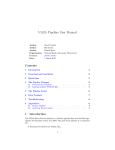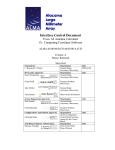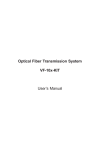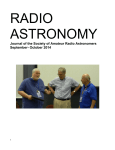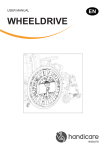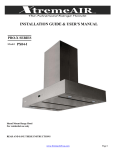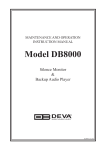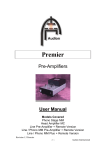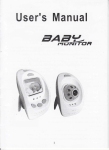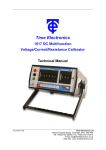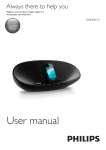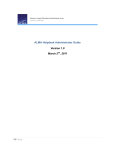Download LabVIEW Control Software for ATF Holography Receiver
Transcript
LabVIEW Control Software for ATF Holography Receiver ATFD-42.02.00.00-002-A-MAN Version: A02 Status: (Draft, Pending, Approved, Released, or Obsolete) 2006-08-31 Prepared By: Name(s) and Signature(s) Organization Date Christian Holmstedt NRAO 2006-08-22 Approved By: Name and Signature Organization Date Released By: Name and Signature Organization Date ALMA Project LabVIEW Control Software for ATF Holography Receiver Doc # : ATFD-42.02.00.00-002-A-MAN Date: 2006-08-31 Status: Draft (Draft, Pending, Approved,Released,Superceded, Obsolete) Page: 2 of 14 Change Record Version Date A 2006-08-22 Affected Section(s) all A02 2006-08-31 4.3, 5.2 2006-09-05 4.1.4 Change Request # - Reason/Initiation/Remarks Initial draft Added expected operating temps. Modified tuning sequence. Added nominal values for ‘LO level’. ALMA Project LabVIEW Control Software for ATF Holography Receiver Doc # : ATFD-42.02.00.00-002-A-MAN Date: 2006-08-31 Status: Draft (Draft, Pending, Approved,Released,Superceded, Obsolete) Page: 3 of 14 Table of Contents 1 2 3 4 INTRODUCTION........................................................................................................ 4 REFERENCE DOCUMENTS. .................................................................................... 4 INSTALLATION AND SETUP.................................................................................. 4 USER INTERFACE (GUI).......................................................................................... 5 4.1 ‘Settings’ tab.......................................................................................................... 5 4.1.1 Attenuator Control .......................................................................................... 5 4.1.2 Synthesizer Control......................................................................................... 6 4.1.3 PLL / Gunn control ......................................................................................... 7 4.1.4 Signal Levels................................................................................................... 8 4.1.5 Environmental Data ........................................................................................ 8 4.2 ‘DSP Graph’ tab .................................................................................................... 9 4.3 ‘Temp Graph’ tab ................................................................................................ 10 4.4 ‘Path length measurement’ tab ............................................................................ 10 4.5 ‘I/O Interface’ tab ................................................................................................ 10 5 CONTROLLING THE HARDWARE....................................................................... 11 5.1 Connecting and disconnecting to the CAN bus................................................... 11 5.2 Basic Holography Rx tuning. .............................................................................. 12 ALMA Project LabVIEW Control Software for ATF Holography Receiver 1 Doc # : ATFD-42.02.00.00-002-A-MAN Date: 2006-08-31 Status: Draft (Draft, Pending, Approved,Released,Superceded, Obsolete) Page: 4 of 14 Introduction This document is a short User Manual for the LabVIEW Control Software used to control the ATF Holography receiver. It runs under Win2K and WinXP. It might run under Win98 but it has not been tested. The software controls the electronics using the CAN Interface or by tunneling the CAN commands through Ethernet using TCP/IP communication. In the latter case a script is running on the ABM. The software is distributed in two versions, a compiled stand-alone version and the source code. The latter needs a full LabVIEW license to run. It was developed using LabVIEW 7 but the source code will compile under newer versions too. This document will focus on the stand-alone executable. The document does not describe the low-level communication protocols used and is intended to be a User Manual including basic tuning procedures for the receiver. 2 Reference Documents. RD1 – Interface Control Document between ATF Holography Receiver and Control Software – ALMA-42.02.00.00-75.35.25.00-A-ICD. 3 Installation and setup. The software needs drivers for a National Instruments CAN Interface to run. Make sure NI-CAN 1.6 (or later) is installed before the Control Software is installed. The Installer creates an entry under the Programs menu accessible from the Start menu just like any other Windows program. Start the program by clicking Start -> Programs -> Full Holography test Dual Interface 1.0.2. ALMA Project LabVIEW Control Software for ATF Holography Receiver 4 Doc # : ATFD-42.02.00.00-002-A-MAN Date: 2006-08-31 Status: Draft (Draft, Pending, Approved,Released,Superceded, Obsolete) Page: 5 of 14 User Interface (GUI) The user interface consists of a main window with five tabs named (from left to right) ‘Settings’, ‘DSP Graphs’, ‘Temp Graphs’, ‘Distance measurement’ and ‘I/O Interface’, see Figure 1. Figure 1. 4.1 ‘Settings’ tab. This is the main tab used for controlling the Holography receiver and it’s divided in six sub panels as described below. The tab also has a ‘Stop’ button to stop the software and all CAN communication is terminated properly when using it. Detailed description about all Monitor and Control commands can be found in the Holography Receiver ICD [RD1]. 4.1.1 Attenuator Control Both Signal and Reference channel attenuators are controlled from this panel. The valid range is 0 – 63dB in step of 1dB. On power up these attenuators are set to 0 dB by default in the Holography receiver. To enable the controls the ‘Enable Control’ button has to be activated. There are two green indicators for the power level of the IF and Ref channel. When lit, there is enough power. When any of the two attenuator values are changed the corresponding red indicator will flash to indicate that the command has been sent, see Figure 2. Figure 2. Attenuator control ALMA Project LabVIEW Control Software for ATF Holography Receiver 4.1.2 Doc # : ATFD-42.02.00.00-002-A-MAN Date: 2006-08-31 Status: Draft (Draft, Pending, Approved,Released,Superceded, Obsolete) Page: 6 of 14 Synthesizer Control The synthesizer frequency and status are shown on this panel. The frequency in MHz is entered and sent immediately to the synthesizer when the ‘Enable Control’ check box is checked.. A red indicator will flash every time a new command is sent. A green light indicated when the synthesizer is locked. The default frequency for operating the Low band is 8755 MHz and for the High band 9445 MHz. Figure 3. Synthesizer control. For ‘High band’ (FRF = 104020 MHz) the synthesizer frequency is: Fsyntth = (FRF – 95 – FIF) / N FIF = 30 MHz, N = 11 For ‘Low band’ (FRF = 78920 MHz) the synthesizer frequency is: Fsynth = (FRF – 95 – FIF) / N FIF = 30 MHZ, N = 9 ALMA Project LabVIEW Control Software for ATF Holography Receiver 4.1.3 Doc # : ATFD-42.02.00.00-002-A-MAN Date: 2006-08-31 Status: Draft (Draft, Pending, Approved,Released,Superceded, Obsolete) Page: 7 of 14 PLL / Gunn control Figure 4 shows the PLL and Gunn control panel. The ‘Enable Control’ check box needs to be checked to send commands. To lock the Gunn a Gunn Bias, Loop Gain and PLL Tune Range needs to be entered. This can be done manually or by loading previously used values from file. Default values for both High and Low band Gunn can be found in Table 1. Figure 4. PLL / Gunn control. The High or Low band Gunn Oscillator is selected with the ‘Gunn select’ control. When switching between the two Gunn Oscillators the bias voltage is disabled and the Gunn put in ‘Open Loop’ operation, i.e. the PLL loop is disabled and needs to be manually turned on. Basic tuning of the Holography receiver is described in sect 5.2. Synth. freq. [MHz] Gunn Bias [V] Loop Gain [ohm] PLL Tune Range [ohm] Gunn Oscillator Low 8755 9.09668 1992.1875 50000 High Table 1. Default Synth / PLL / Gunn parameters. 9445 9.365234 1992.1875 19921.875 ALMA Project LabVIEW Control Software for ATF Holography Receiver 4.1.4 Doc # : ATFD-42.02.00.00-002-A-MAN Date: 2006-08-31 Status: Draft (Draft, Pending, Approved,Released,Superceded, Obsolete) Page: 8 of 14 Signal Levels Figure 5 shows the signal level panel. Mark the parameter you want to monitor in the check box next to the indicator. The update interval in ms can be set in the ‘Update interval’ control. The shortest interval is 125 ms Default is 250 ms. Figure 5. Signal Levels. Full scale readouts for Signal and Reference I and Q channels are 20V. For best performance you will need as much power as possible on the Reference and Signal channel without saturating the receiver. 75% - 95% of full is a good level to aim for. Nominal values for ‘LO level’ is ~1.77V for High band and ~1.55V for Low band operation. No signal indicates the Gunn Oscillators have failed or that they are not biased properly. 4.1.5 Environmental Data This panel shows internal temperatures and power consumption of the Holography receiver. Readouts have to be enabled with the ‘Enable’ check box. Temperature data can be logged to file and plotted to screen with an interval set by the ‘Interval’ control. To log data to file the ‘Plot temp data’ must be enabled together with ‘Log temps to file’. Temperature graphs are shown on the ‘Temp Graphs’ tab (see 4.3). ALMA Project LabVIEW Control Software for ATF Holography Receiver Doc # : ATFD-42.02.00.00-002-A-MAN Date: 2006-08-31 Status: Draft (Draft, Pending, Approved,Released,Superceded, Obsolete) Page: 9 of 14 Figure 6. Environmental Data. Nominal supply current during operation is ~1.3 to 1.4A depending on ambient temperature. 4.2 ‘DSP Graph’ tab Plots the raw data from the DSP channels QQ, QR, QS, RR, RS, SS on screen normalized to ±1 full scale. Select what data to plot with the check boxes. Averaging can be applied by entering the number of samples to average in the ‘Samples to average’ control and turning averaging ON. The SS signal is directly proportional to the power level in the Signal channel and RR is directly proportional to the power level in the Reference channel. The indicator ‘Number of samples’ shows the number of samples in each 12ms integration cycle. This number should be identical for each cycle and the correct reading is 600. Any deviation indicates that the 25MHz and 48ms signals are not phase locked. ALMA Project LabVIEW Control Software for ATF Holography Receiver Doc # : ATFD-42.02.00.00-002-A-MAN Date: 2006-08-31 Status: Draft (Draft, Pending, Approved,Released,Superceded, Obsolete) Page: 10 of 14 Figure 7. DSP plot 4.3 ‘Temp Graph’ tab Displays the internal temperatures of the Holography receiver. Temperatures inside the receiver can be expected to be ~20 deg C above ambient temperature during operation. 4.4 ‘Path length measurement’ tab Takes the raw data from the DSP and calculates the path length difference between Signal and Reference channel in µm. 4.5 ‘I/O Interface’ tab Used for starting and stopping communication to the Holography receiver. This is also where the user can select to use direct CAN communication or use CAN over Ethernet. ALMA Project LabVIEW Control Software for ATF Holography Receiver 5 5.1 Doc # : ATFD-42.02.00.00-002-A-MAN Date: 2006-08-31 Status: Draft (Draft, Pending, Approved,Released,Superceded, Obsolete) Page: 11 of 14 Controlling the hardware. Connecting and disconnecting to the CAN bus. Before any communication with the hardware can be done the bus has to be scanned for connected CAN nodes. CAN communication can be done with either ‘CAN direct’ (using a local CAN interface) or by tunneling CAN commands over Ethernet. Figure 8. CAN Connect / Disconnect Figure 8 show the message before the bus has been scanned. Press ‘Scan & Connect to CAN bus’ to find the two nodes of the Holography Rx on the bus. If no connection has been established a NOT FOUND error will be displayed. The holography receiver uses two CAN nodes. Node 1 is used for the DSP unit and shall have an address of 0x1D. Node 2 is used for all other monitor and control points and shall have an address of 0x1C. The message looks like this if no nodes are found: Program running. Do not turn off power to Holography Rx. CAN node with address x1D NOT FOUND ---------CAN node with address x1C NOT FOUND ---------- ALMA Project LabVIEW Control Software for ATF Holography Receiver Doc # : ATFD-42.02.00.00-002-A-MAN Date: 2006-08-31 Status: Draft (Draft, Pending, Approved,Released,Superceded, Obsolete) Page: 12 of 14 If everything is OK the message looks like this: Program running. Do not turn off power to Holography Rx. CAN node with S/N: nn nn nn ---------CAN node with S/N: nn nn nn ---------- address x1D found at node index xnn nn nn nn nn nn address x1C found at node indes xnn nn nn nn nn nn Before the software can be closed the user has to disconnect from the CAN bus. Not doing so will leave the bus open and this can cause problems when connecting again. Press ‘Disconnect from CAN bus’ to close the connection. The following message is displayed. Program running. Communication with CAN bus closed. It is now safe to turn off power to the Holography Rx. 5.2 Basic Holography Rx tuning. The Holography works on two frequency bands (~79GHz and ~104GHz) called Low and High and there are two presets that will tune the receiver to those two frequencies. The tuning operation is described below. The Holography Receiver can be tuned ±150 MHz relative to the two primary frequencies by setting the synthesizer frequency. Minimum step size for the synthesizer is 125 kHz. Tuning the Low band. 1. Make sure CAN communication has been established 2. ‘Enable’ all controls on the ‘Settings’ tab. DSP readout and plotting can be activated at this point. 3. Select ‘Low Band Gunn’. 4. Set synthesizer frequency to 8755.000 MHz. 5. Check if synthesizer is locked (Synthesizer sub panel). Abort sequence if not locked. The most likely reason is that the 25 MHz signal is missing. 6. Set the PPL to run in ‘Open Loop’ on the PLL / Gunn sub panel. 7. Set ‘GunnL Loop Gain’ to 1992.1875 ohm. ALMA Project LabVIEW Control Software for ATF Holography Receiver Doc # : ATFD-42.02.00.00-002-A-MAN Date: 2006-08-31 Status: Draft (Draft, Pending, Approved,Released,Superceded, Obsolete) Page: 13 of 14 8. Set ‘PLL Tune Range L’ to 50000 ohm. 9. Turn on Gunn Bias by pressing ‘Bias On/Off’. 10. Set ‘Low band Gunn Bias’ to 9.09668 Volt. Verify that the Gunn is biased. 11. Set PLL to run in ‘Closed Loop’. 12. Check that the Gunn Oscillator is locked. The indicators should be lit (PLL / Gunn sub panel). 13. Adjust Signal and Reference attenuators until a good signal level (~75% of full scale. Higher is better for maximum dynamic range just make sure the hardware is not saturated) can be seen on the REF and SIG I and Q channels on the ‘Signal Level’ sub panel. 14. Check that the DSP is working by going to the ‘DSP Graph’ tab.Check that the ‘Number of samples’ reads back a decimal value of 600. A stream of data should be present on the screen. If all readouts are flat lines or no data can be seen press ‘Reset DSP’ on the ‘DSP Data’ sub panel on the ‘Settings’ tab. When changing Signal and Reference attenuation the SS and RR data shall move up and down accordingly. Tuning the High band. 1. Make sure CAN communication has been established. 2. ‘Enable’ all controls on the ‘Settings’ tab. DSP readout and plotting can be activated at this point. 3. ‘Select ‘High Band Gunn’. 4. Set synthesizer frequency to 9445.000 MHz. 5. Check if synthesizer is locked (Synthesizer sub panel). Abort sequence if not locked. The most likely reason is that the 25 MHz signal is missing. 6. Set the PLL to run in ‘Open Loop’. 7. Set ‘GunnH Loop Gain’ to 1992.1875 ohm. 8. Set ‘PLL Tune Range H’ to 19921.875 ohm. 9. Turn on Gunn Bias by pressing ‘Bias On/Off’ 10. Set ‘High band Gunn Bias’ to 9.365234 Volt. Verify that Gunn is biased. 11. Set PLL to run in ‘Closed Loop’. 12. Check that the Gunn Oscillator is locked. The indicators should be lit (PLL / Gunn sub panel). 13. Adjust Signal and Reference attenuators until a good signal level (~75% of full scale. Higher is better for maximum dynamic range just make sure the hardware is not saturated) can be seen on the REF and SIG I and Q channels on the ‘Signal Level’ sub panel. 14. Check that the DSP is working by going to the ‘DSP Graph’ tab. Check that the ‘Number of samples’ reads back a decimal value of 600. A stream of data should be present on the screen. If all readouts are flat lines or no data ALMA Project LabVIEW Control Software for ATF Holography Receiver Doc # : ATFD-42.02.00.00-002-A-MAN Date: 2006-08-31 Status: Draft (Draft, Pending, Approved,Released,Superceded, Obsolete) Page: 14 of 14 can be seen press ‘Reset DSP’ on the ‘DSP Data’ sub panel on the ‘Settings’ tab. When changing Signal and Reference attenuation the SS and RR data shall move up and down accordingly. Depending on ambient temperature and temperatures inside the Holography receiver the Gunn Bias voltage might have to be tweaked a little bit up or down to get the Gunn oscillators to lock. The settings can be saved or recalled from file by pressing the corresponding ‘Load’ and ‘Save’ button for the either the high or low band Gunn.















